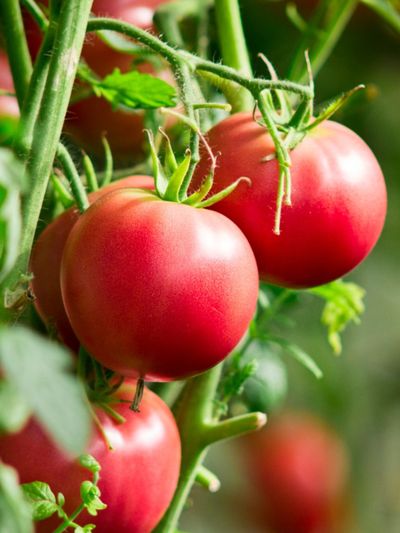Types of Tomatoes
Some of the most common types of tomatoes include:
CherryMain Crop/Mid-SeasonRomaBeefsteakLong Keepers
Cherry tomatoes are easy to grow and mature quite early. These small, bite-sized snacks are a big hit with children and can be easily grown in containers. Oftentimes the most widely grown in home gardens, the Main Crop varieties produce an exceptional harvest during mid-season. Roma tomatoes, sometimes referred to as Plum tomatoes, are generally small and elongated. These tomatoes are normally grown for canning purposes. The commonly known Beefsteak is considered to be the Big Daddy of tomatoes because of its large size, making these veggies perfect for making sandwiches. This type usually does not mature until well into the growing season, however. Many yellow or orange tomatoes are considered Long Keepers as they can normally be stored for several months provided the area is cool and dark.
How to Care for Tomatoes
You may be wondering how to take care of tomato plants. The good news is that given the proper climatic conditions, you can grow tomatoes nearly anywhere. The soil should consist of organic matter, usually in the form of compost, with sufficient amounts of fertilizer and moisture. When growing tomatoes, you should start early since most take a while to mature. If you are unfamiliar with growing tomatoes from seeds, you may want to consider purchasing the plants themselves; many of which are widely available at most garden centers and nurseries. The seeds normally take six to eight weeks of growing and must be hardened off before they are transplanted into the garden. They can be started in a window box or in small flats and then transplanted into small pots, paper cups with adequate drainage holes, or other containers once the seedlings have become sturdy enough. Thin the seedlings as needed and pinch the tops to create stronger, stockier plants. Planting distances for tomatoes generally depend on the variety. These can also be found on the seed packets or by referring to the planting guidelines for your area.
Tomato Plant Care
Tomatoes don’t thrive in cool conditions; they require an average temperature of 65 F. (18 C.) or higher to ripen. Therefore, be sure to wait until any threat of frost has passed before setting your plants in the garden. Tomatoes require areas with full sun and should have adequate protection from strong winds as well. To help tomato seedlings become sturdier, you can lay them on their sides and cover them with soil. Leave the tops exposed; after a couple days, the tops will straighten and begin to grow upright. Once tomato plants become sturdy enough, you should stake them for further support. Staking tomatoes also makes harvesting easier, as the fruits are more accessible since they are kept off the ground. Tomatoes require a lot of water; therefore, to help retain moisture, you should always mulch tomato plants. You should also have tomato plants situated in an area that is easily accessible to water. Check tomato plants daily for any ripe produce; picking often will encourage more production. Once the end of growing season has neared, it’s helpful to remove any blossoms as well to encourage nutrients to reach existing fruits. If you still have an abundance of green tomatoes during this time, go ahead and pick them. These can be stored in a warm, moist area up to four weeks, eventually ripening and turning red.
Tomatoes and Pests
You should also periodically check your plants to make sure they are healthy. Tomato plants emit a mild toxin that discourages many small insects from bothering them, but common pests can pose significant problems if not taken care of. These include:
cutwormsbeetlesaphidshornwormstomato fruitwormswhiteflies
Many of these insects can be easily removed by hand or with the use of soapy water sprays. Chemical insecticides aren’t generally recommended. Planting flowers with strong aromas, such as marigolds, can also help fight off pests. Disease problems are often the result of poor conditions such as inadequate nutrients, water, sun, or space; pathogens such as fungi, bacteria, or viruses; and weather. With proper care and maintenance, however, most problems can easily be overcome. Also, if your particular area is prone to certain types of pests or diseases, choose varieties that are listed as resistant.
